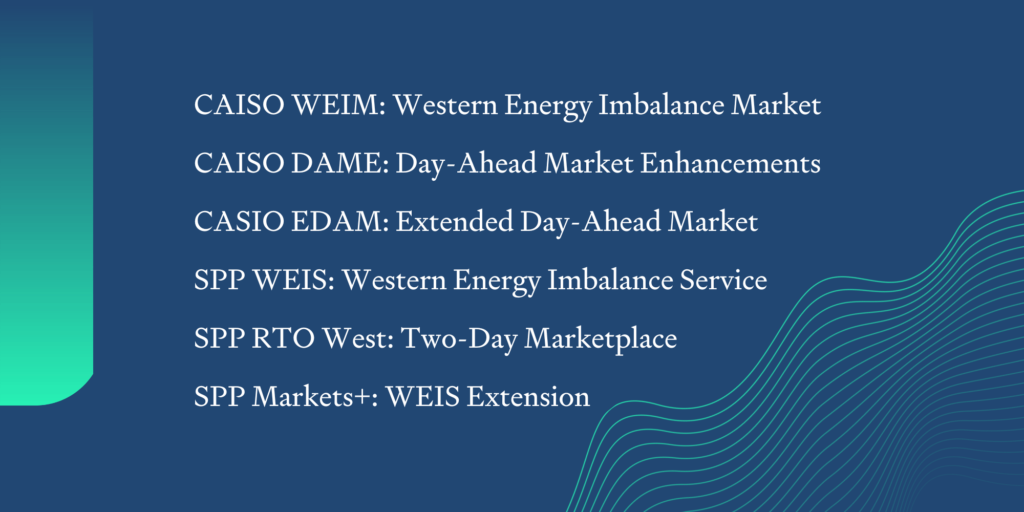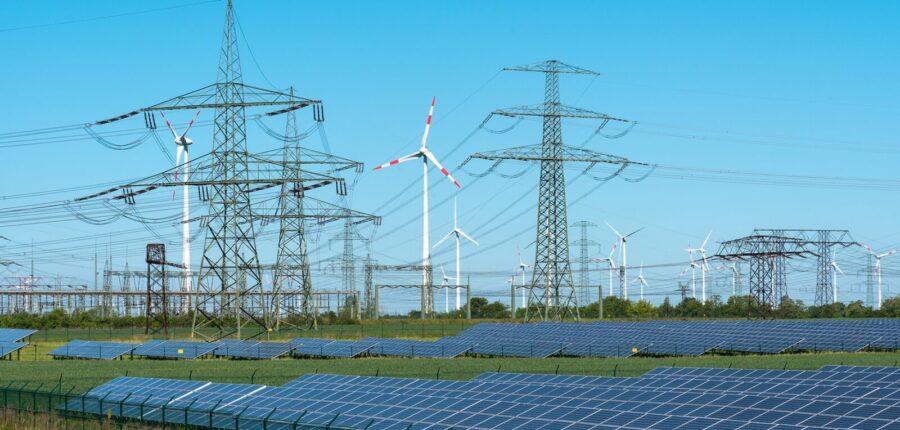The energy markets in the western U.S. are dynamic and unique. Thanks to lower average population densities, a large amount of federally owned land, the distance between population centers, and cultural differences, concepts that work on the east coast or in the middle of the country don’t necessarily apply to the west.
Accordingly, the region has developed its own way of doing things.
Currently, there are two prominent players in the west market. The California Independent System Operator (CAISO) operates both the California-centric two-day Market Redesign and Technology Upgrade (MRTU) and the real-time Western Energy Imbalance Market (WEIM), covering portions of six western states. The Southwest Power Pool (SPP) operates the Western Energy Imbalance Service (WEIS) for participants in the Western Interconnection as well as the Western Resource Adequacy Program (WRAP). SPP also operates a two-day market in the Eastern Interconnect, the Southwest Power Pool Integrated Marketplace (SPPIM). These two organizations are shaping the future of the west markets. Here’s how.
Current state: WEIM and WEIS
WEIM
CAISO introduced the Western Energy Imbalance Market in 2014. The first of its kind in the Western Interconnect, the WEIM is a real-time energy-only market designed to leverage resource diversity across several Western states. It was a game changer because it created an organized regional real-time market by opening CAISO’s advanced Security Constrained Unit Commitment (SCUC) and other technology investments to entities outside its ISO territory (roughly the state boundary of California).
The WEIM enables energy transfers between balancing areas, allowing members to automatically buy and sell lower-cost electricity near the time it’s consumed. Simply put, it offers a regimented hour-to-hour workflow that monetizes virtually all utility behaviors from week-ahead planning up to real-time operations and all the way through settlement validations and financial reporting.
Precision and accuracy are two of the hallmarks of the WEIM, giving participants real-time visibility into surrounding electric grids and an improved ability to balance fluctuations in supply and demand. Covering the vast expanses of the west provides the WEIM a unique view into renewable production across a geographically diverse region to assist in the real-time management of variable energy resources, significantly reducing renewable energy curtailments by routing that excess production to other regions of the west that are less windy/sunny.
The WEIM has been transformational and far more successful than many thought possible; it claims to have generated more than $2 billion in gross economic benefits for its participants since its launch. One item to note regarding these benefits, they have steadily grown as market participation has increased, a reminder that increased coordination and collaboration is still a wellspring of benefits (more overall transfer capacity = more overall benefits).
WEIS
In February 2021, SPP launched the Western Energy Imbalance Service (WEIS). Like the WEIM, it’s a real-time energy imbalance market open to entities outside SPP’s regional transmission organization (RTO), primarily entities on the eastern side of the western interconnect.
WEIS fulfills the same need as the WEIM, though it’s less focused on precision and accuracy. Essentially, SPP removed the complexity of an imbalance market and put it inside one charge code. For example, there are no pre-hour base schedule submissions in the WEIS workflow (I know, all my WEIM friends’ ears are probably smoking as they consider the implications of no base schedules! But it does work, it just makes Energy Settlement quite complex). WEIS requires entities to only submit economic bids, ancillary service plans, commitment plans, and non-conforming load forecasts to SPP. SPP WEIS validates supply adequacy (a simplified resource sufficiency evaluation, in WEIM terms) and then issues 5-min dispatch instructions to WEIS participants from the WEIS security-constrained economic dispatch engine. Benefits are created through increased renewable utilization and transfers between areas, like WEIM. SPP has not yet formally published WEIS benefits.
Another significant difference between WEIM and WEIS is that while CAISO has not announced a sunset date for the WEIM, SPP will replace WEIS as soon as its next market iteration (Markets+ or RTO West) is ready.
On the horizon: DAME, EDAM, RTO West, and Markets+
CAISO and SPP are at various stages of market design for their next round of initiatives, though neither has announced firm timelines. Here’s what we know.
CAISO: DAME and EDAM
The next step for CAISO is the Day-Ahead Market Enhancements (DAME). With the WEIM, CAISO has spent the last ten+ years optimizing efficiencies in the real-time market (dating back to at least FERC 764). Now they’re working on challenges that can only be solved by planning one day out; they’re seeking to reduce/eliminate remaining ‘seams’ issues between DA & RT markets.
The significant change that’s coming is new market products called imbalance reserves. You can think of these as a day-ahead flex or an insurance policy against your forecast errors. It’s energy that needs to be procured a day ahead to account for uncertainties that may be realized in real-time. By procuring this in the day ahead timeframe, CAISO can better position the overall system with increased flexibility (improved resiliency to forecast errors).
DAME is currently slated to be rolled out in the fall of 2023. The following year, CAISO is expected to launch the next phase of the market initiative, EDAM, or Extended Day-Ahead Market.
Whereas the WEIM is real-time, with optimization happening in five- and 15-minute intervals, the EDAM is an hourly optimization for the next day. EDAM opens CAISO’s IFM (Integrated Forward Market) and associated technology to Western Balancing Authorities who have elected to participate in EDAM. This situation provides a significant opportunity for benefit creation by providing the market the ability to commit resources across a broader western footprint and for longer start times (WEIM only looks 4.5 hours into the future currently, so commitments are limited to short/quick start resources, those able to start up in under 4.5 hours).
SPP: RTO West and Markets+
SPP is working on two initiatives that could replace WEIS: RTO West and Markets+. Market participants in this fiercely independent section of the country will determine which model is ultimately implemented.
RTO West is a traditional two-day marketplace. It takes the SPP integrated market tariff and applies it to areas on the eastern side of the Western interconnect. The net result is the dissolution of the individual balancing authorities, making the market operator responsible for the region’s electric reliability. Transmission planning and buildout would also be centralized with RTO West.
The RTO West concept represents a significant change in how the region’s utilities do business. While it appears to have momentum among stakeholders, whether participants will be willing to make the shift is unknown. RTO West could go live sometime in 2024 or 2025.
Markets+ is the other offering SPP is developing in collaboration with many western stakeholders. This concept is an extension of the Western Energy Imbalance Service (WEIS). In this scenario, geographic diversity is still leveraged, but the individual balancing authorities are not dissolved; each utility retains responsibility for its reliability and transmission buildouts. You can think of this as SPP’s alternative to CAISO’s EDAM: maintain the balancing authority but extend the timeframe of collaboration and coordination from the next hour (WEIM & WEIS) to the next day (EDAM & Markets+).

Now's the time to act
We don’t know what the next evolution of the west markets will look like. We’ve seen these types of initiatives before; they show up and get great fanfare yet fail to gain real traction and get implemented. I can tell you that more coordination and collaboration are better for everybody, particularly as we race to a decarbonized future and need to tackle the multitude of challenges that the new world presents us with!
This uncertainty is unsettling, but there are things you can do now to set your utility up for success, regardless of how you go as a market participant. At the end of the day, you have to know what your resources are, your resource adequacy, and what your portfolio looks like. You must know how you use those resources in the short-, mid-, and long-term. And that’s where PCI Energy Solutions can help. We offer market-agnostic tools that enable you to optimize your resources, schedule trades, and analyze data to inform decisions around forecasting and operations. We also offer market-specific tools to communicate with market operators. For PCI, it’s simple: we monitor the initiatives and build the tools needed as these initiatives become a reality.
While the markets sort themselves out through their stakeholder and governance processes, this is the perfect time to make sure you have the best workflows in place. Then, once you have clarity on your direction, you can tap into the market of your choice with PCI’s market-facing products.







